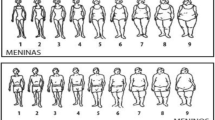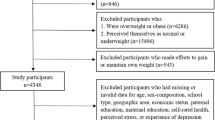Abstract
Unhealthy weight control behaviors may be precursors to clinical eating disorders; therefore, it is important to identify these actions, and what may trigger them, as early as possible. We used 2009 and 2011 Massachusetts Youth Health Survey data for middle and high school students. We studied age, sex, and race disparities related to unhealthy weight control behaviors in conjunction with other risk factors such as body mass index (BMI), body weight perception, involvement in bullying, and depressive symptoms. The surveys were completed in public schools. Bivariate and multinomial regression analyses were conducted to assess associations between weight control behaviors and BMI categories, body weight perception, bullying involvement, and depressive symptoms. Poor body weight perception, bullying involvement, and depressive symptoms were associated with significantly elevated odds of reporting unhealthy weight control behaviors in both middle and high school students. Most patterns were consistent for middle and high school students, with obesity and bullying involvement being prevailing risks for high school students. Though females were more likely to report unhealthy weight control behaviors we also showed the rarely presented prevalence of male involvement in disordered eating behaviors including those who perceived themselves to be underweight. Health education classes and school-based interventions may be two strategies to help prevent the development of unhealthy weight control behaviors. Continuation of youth surveys that gather data on weight control behaviors and known risk factors is essential for observing changes in behaviors over time.
Similar content being viewed by others
Abbreviations
- YHS:
-
Youth Health Survey
- YRBS:
-
Youth Risk Behavior Survey
- BMI:
-
Body mass index
- CI:
-
Confidence interval
- OR:
-
Odds ratio
References
Forman-Hoffman, V. (2004). High prevalence of abnormal eating and weight control practices among U.S. high-school students. Eating Behaviors, 5, 325–336.
Farrow, C. V., & Fox, C. L. (2011). Gender differences in the relationships between bullying at school and unhealthy eating and shape-related attitudes and behaviours. British Journal of Educational Psychology, 81, 409–420.
Eichen, D. M., Conner, B. T., Daly, B. P., et al. (2012). Weight perception, substance use, and disordered eating behaviors: Comparing normal weight and overweight high-school students. Journal of Youth and Adolescence, 41, 1–13.
Kaltiala-Heino, R., Rimpela, M., Rantanen, P., et al. (2000). Bullying at school—An indicator of adolescents at risk for mental disorders. Journal of Adolescence, 23, 661–674.
McKenna, M., Hawk, E., Mullen, J., et al. (2011). Bullying among middle school and high school students—Massachusetts, 2009. MMWR, 60(15), 465–471.
Robinson, S. (2006). Victimization of obese adolescents. The Journal of School Nursing, 22(4), 201–206.
Center for Disease Control and Prevention. (2011). A SAS program for CDC growth charts. http://www.cdc.gov/nccdphp/dnpao/growthcharts/resources/sas.htm. Accessed September 15, 2011.
Rosner, B. (2005). Fundamentals of biostatistics (6th ed.). Pacific Grove, CA: Duxbury Press.
Austin, S. B., Spadano-Gasbarro, J. L., Greaney, M. L., et al. (2011). Disordered weight control behaviors in early adolescent boys and girls of color: An under-recognized factor in the epidemic of childhood overweight. Journal of Adolescent Health, 48(1), 109–112.
Chao, Y. M., Pisetsky, E. M., Dierker, L. C., et al. (2008). Ethnic differences in weight control practices among U.S. adolescents from 1995 to 2005. International Journal of Eating Disorders, 41(2), 124–133.
Striegel-Moore, R. H., Dohm, F. A., Pike, K. M., et al. (2002). Abuse, bullying, and discrimination as risk factors for binge eating disorder. American Journal of Psychiatry, 159, 1902–1907.
Sweetingham, R., & Waller, G. (2008). Childhood experiences of being bullied and teased in the eating disorders. European Eating Disorders Review, 16, 401–407.
Fosse, G. K., & Holen, A. (2006). Childhood maltreatment in adult female psychiatric outpatients with eating disorders. Eating Behaviors, 7, 404–409.
Suisman, J. L., Slane, J. D., Burt, S. A., et al. (2008). Negative affect as a mediator of the relationship between weight-based teasing and binge eating in adolescent girls. Eating Behaviors, 9(4), 493–496.
Austin, S. B., Field, A. E., Wiecha, J., et al. (2005). The impact of a school-based obesity prevention trial on disordered weight-control behaviors in early adolescent girls. Archives of Pediatrics and Adolescent Medicine, 159, 225–230.
Austin, S. B., Spadano-Gasbarro, J. L., Greaney, M. L., et al. (2012). Effect of the planet health intervention on eating disorder symptoms in Massachusetts middle schools, 2005–2008. Preventing Chronic Disease, 9,120111. doi:10.5888/pcd9.120111.
Austin, S. B. (2011). The blind spot in the drive for childhood obesity prevention: Bringing eating disorders prevention into focus as a public health priority. American Journal of Public Health, 101(6), e1–e4.
Neumark-Sztainer, D. R., Wall, M. M., Haines, J. I., et al. (2007). Shared risk and protective factors for overweight and disordered eating in adolescents. American Journal of Preventive Medicine, 33(5), 359–369.
Attendance Works. (2013). Springfield’s walking school bus improves attendance, health and safety. http://www.attendanceworks.org/springfields-walking-school-bus-improves-attendance-health-and-safety/. Accessed January 30, 2013.
French, S. A., Peterson, C. B., Story, M., et al. (1998). Agreement between survey and interview measures of weight control practices in adolescents. International Journal of Eating Disorders, 23, 45–56.
Acknowledgments
We would like to thank all of the students who participated in the 2009 and 2011 Massachusetts Youth Health Survey. We would also like to thank Anthony Roman and Chiniqua Milligan for their help with data collection and recruitment efforts. Thank you to Maria McKenna for her comments and guidance on data analysis. Thank you to Anne Sheetz for her help discussing school based interventions. Support for this study was provided by the Massachusetts Department of Public Health.
Conflict of interest
None.
Author information
Authors and Affiliations
Corresponding author
Rights and permissions
About this article
Cite this article
Gonsalves, D., Hawk, H. & Goodenow, C. Unhealthy Weight Control Behaviors and Related Risk Factors in Massachusetts Middle and High School Students. Matern Child Health J 18, 1803–1813 (2014). https://doi.org/10.1007/s10995-013-1424-5
Published:
Issue Date:
DOI: https://doi.org/10.1007/s10995-013-1424-5




